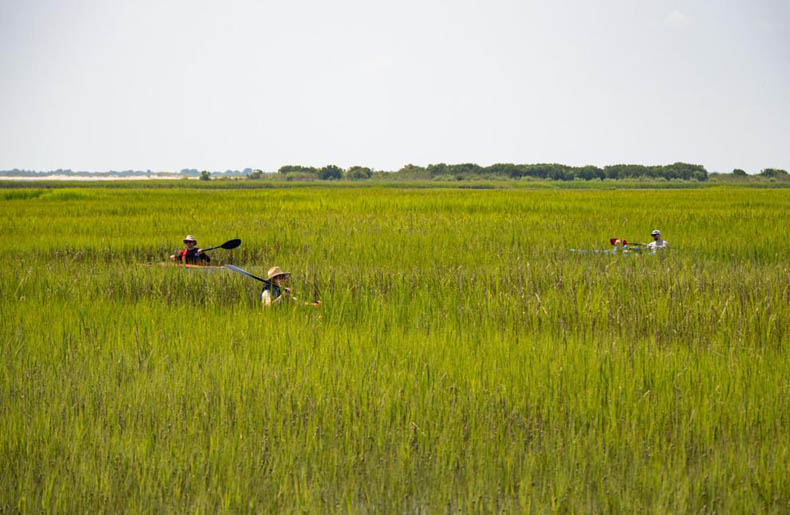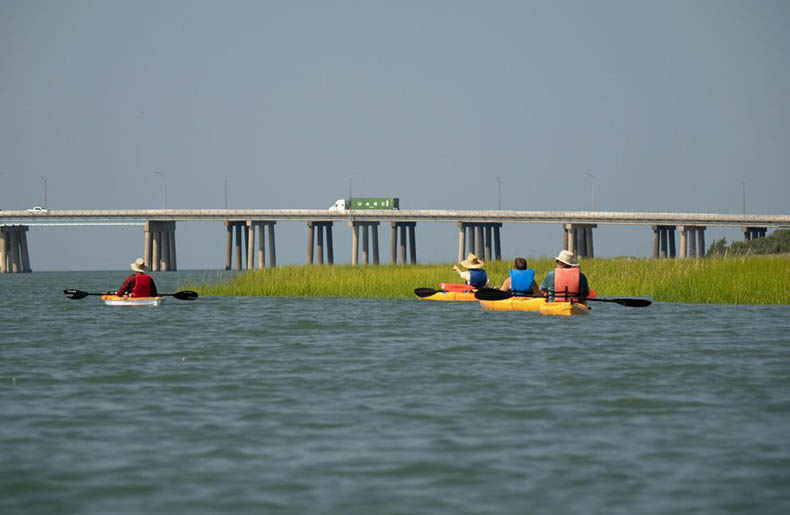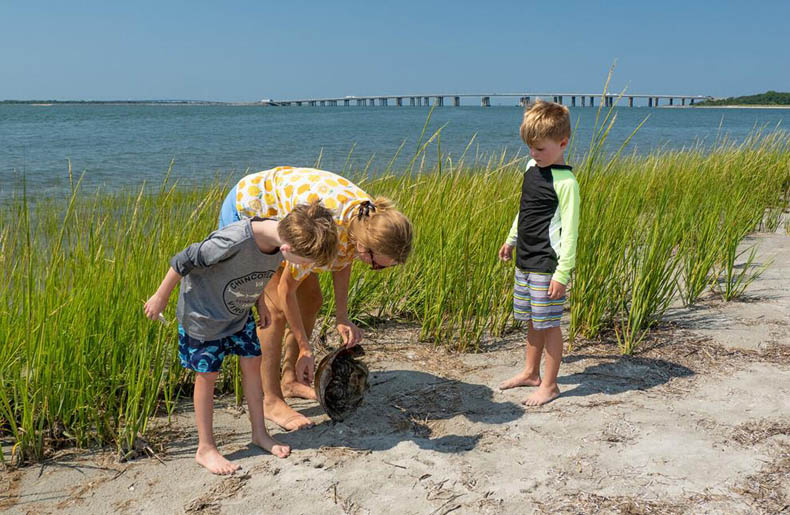|
An interesting feature during this early part of the paddle: When members of our motley crew would maneuver around a sharp bend ahead of the others, they wouldn't disappear behind it. The marsh was too short for that. Instead, they transformed into disembodied heads gliding above the tips of the green grass blades. Wearing an oversized straw hat with rainbow trim, Karlok's appearance above the grassline provided an odd but conspicuous guide to her trailing fleet.

Kayakers return to Wise Point, Va., through a maze of salt marsh.
When novice paddlers book a trip, Karlok said she typically directs them to the Wise Point tour.
"This one is so great for beginner paddlers," she said. "You're just winding through the marsh in a real controlled environment and the water is shallow, so the risk is real low. Plus, there are so many natural features that are really easy to highlight."
Karlok paused at regular intervals to give short talks on the evolving landscape. Keeping in mind that her audience included a 5-year-old, she generally kept her comments down to earth. A sampling: "This whole area is part of a big wildlife habitat that we want to keep preserved."
The barrier islands and coastal mainland along the Eastern Shore of Virginia's Atlantic-facing flank constitute one of the longest stretches of undeveloped shoreline on the U.S. East Coast. Land held in conservation by The Nature Conservancy as well as the state and federal governments shields about 60 miles of coastline from the concrete between Wise Point and Wallops Island.

Jeff Squire and his son Wade paddle a tandem kayak through a marsh-lined creek near Wise Point, Va.
Each spring, the low-lying islands become the temporary home for more than 100,000 shorebirds on the Atlantic Flyway. Some stay to breed, including the federally endangered piping plover, the state-endangered Wilson's plover and the state-threatened gull-billed tern. As our party of paddlers rounded one of the creek's hairpin turns, Karlok pointed to a mass of sticks near the top of a pine tree about a quarter mile away: a bald eagle nest.
Beneath our hulls lay another treasure: blue crabs. After spawning in the mouth of the Bay, young crabs spend much of their early life sheltered in nearby shallow tidal creeks like the one we were paddling, Karlok said.
"If we don't have these areas, we don't have blue crabs," she added.
Finally, the endless marsh did, in fact, end, and we were greeted by the open water of a constructed boat channel. We pointed our bows to the west and stuck close to the right shoreline to avoid as much of the current's strength as possible.

A group of kayakers paddles toward the Chesapeake Bay Bridge-Tunnel at the tip of the Delmarva Peninsula in Virginia.
In the distance loomed the northernmost leg of the Chesapeake Bay Bridge-Tunnel, the Fisherman Inlet Bridge. But we crossed the channel before we could reach it, landing near the western terminus of Raccoon Island. On the far side lies a house that adventure-seekers can rent by the weekend or the week during part of the year. But our side was devoid of such amenities, consisting instead mostly of bleached sand, fossilized oyster shells and circular divots dug by ghost crabs.
And raccoons? "That's more of a nighttime tour kind of thing," Turner said with the start of a grin. "I've never seen one, but a lot of other people say they have."
Karlok drew the group's attention to a clump of driftwood and long-dead shrubs on the island's edge. These islands play an important role in protecting the peninsula's communities from coastal storms and erosion, she said. To a certain extent, it is natural for such islands to lose ground to the sea on one side and add it to the other. But rising seas, she explained, are endangering their future.
"When we look, we can see how far the island used to go out [into the ocean]," Karlok said. "It's a natural process for the island to change, but it's happening at a much faster rate because of sea level rise."
It was similar to the message I had heard several months earlier when representatives from The Nature Conservancy took me on a boat trip in some of the same waters. (Until the beginning of this season, Karlok was an outreach and education assistant for the conservancy, so that may have had something to do with it.) On that earlier trip, the sights and sounds of nature took a backseat to the outboard motor and me fumbling with technology as I tried to capture content for my Bay Journal podcast.
While that excursion was productive, this one was much more satisfying to my nature-loving heart. Experiencing a landscape by a motorized boat is like driving through a city on the interstate — yes, it's convenient, and you get the general idea of the place, but you miss the finer details.

Tour guide Emma Karlok shows a horseshoe crab shell to brothers Wade and Brody Squire on Raccoon Island, Va.
With noon quickly approaching, the return paddle was a sweaty slog. The less said about it, the better. In all, we had notched a little more than two miles on the water, which felt like enough amid the enveloping heat.
Karlok and Turner dragged their charges safely ashore and made their farewells. They barely had time to wolf down a breakfast bar before it was time for their second tour of the day.
Paddling Wise Point
• Where: The kayak launch is inside the Eastern Shore of Virginia National Wildlife Refuge, 32205 Seaside Road, Cape Charles. Take Ramp Road until about 200 yards before the boat ramp.
• Guided tours: Available from SouthEast Expeditions.
• Access note: Fisherman Island, a national wildlife refuge, is closed to public access to protect wildlife. The island is just south of Raccoon Island and traversed by the Chesapeake Bay Bridge-Tunnel.
This article first appeared in Bay Journal, Vol. 31, #6, Sept 2021.
|








